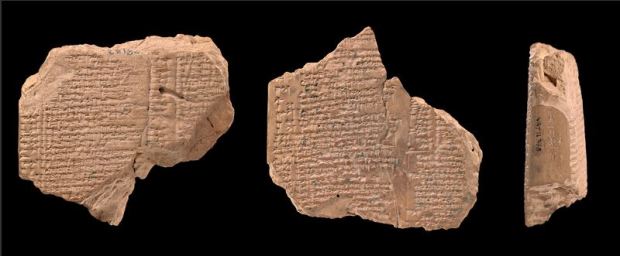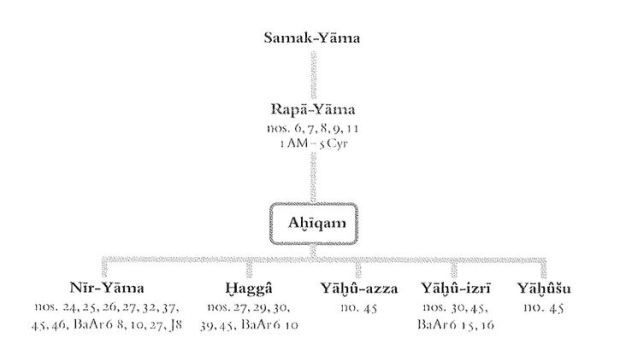Most things that non-Assyriologists know about Babylon, or Mesopotamia in general, stem from the Bible. And in many cases, those are negative things, seeing that Israel was often politically opposed to Mesopotamian civilisations. In this light, I want to bring to you today the story of the Babylonian exile, but this time from the Babylonian point of view.
The Bible versus Babylonian sources
In the Bible we find different accounts of how Nebuchadnezzar, king of Babylon, destroyed the city and captured its inhabitants, a first time in his 7th regnal year (597 BC) and a second time in his 19th year (586 BC). It is this second time which is generally known as the start of the Babylonian exile, when the temple of Jerusalem was destructed.
So Judah went into captivity, away from her land. 28 This is the number of the people Nebuchadnezzar carried into exile: in the seventh year, 3,023 Jews; 29 in Nebuchadnezzar’s eighteenth year, 832 people from Jerusalem; 30 in his twenty-third year, 745 Jews taken into exile by Nebuzaradan the commander of the imperial guard. There were 4,600 people in all. (Jeremiah 52:27-30)
8 On the seventh day of the fifth month, in the nineteenth year of Nebuchadnezzar king of Babylon, Nebuzaradan commander of the imperial guard, an official of the king of Babylon, came to Jerusalem. 9 He set fire to the temple of the Lord, the royal palace and all the houses of Jerusalem. Every important building he burned down. 10 The whole Babylonian army under the commander of the imperial guard broke down the walls around Jerusalem. 11 Nebuzaradan the commander of the guard carried into exile the people who remained in the city, along with the rest of the populace and those who had deserted to the king of Babylon. 12 But the commander left behind some of the poorest people of the land to work the vineyards and fields. (2Kings 25: 8-12)

Jerusalem Chronicle
But Babylonian sources as well inform us about the campaigns of Nebuchadnezzar. The first campaign (in 597 BC) is mentioned in a Chronicle, which is a typical historical text from Babylonia. In those texts, the Babylonians wrote down important historical events with short notes – they are thus some kind of annals. The remarks are often very concise and different events follow eachother at a fast pace. In this case also, the note about the siege of Jerusalem and the capture of its king cannot be compared to the dramatic story of the Bible. The text goes as follows:
In the seventh year [598/597], the month of Kislîmu, the king of Akkad (Nebuchadnezzar) mustered his troops, marched to the Hatti-land, and besieged the city of Judah and on the second day of the month of Addaru he seized the city and captured the king. He appointed there a king of his own choice, received its heavy tribute and sent to Babylon.
(ABC, Jerusalem Chronicle, Rev. 11′-13′)
In fact, this short mention of an event that still has its repercussions today, is surrounded in the text by other, very similar notes about the king marching to other disobedient provinces of his empire to punish them. For the Babylonians, and the Assyrians before them, it was a very normal strategy to destroy key places in those provinces and capture their elite, and later relocate it somewhere else, both in the heartland (Babylon) or in another province. With this strategy, they managed to bring the disobedient people in imbalance, and thus ensured their obedience.
Jews in Babylon(ia)
The Weidner Ration Lists
That the Babylonian exile is a historical fact, is an absolute certainty, but the next question is: what happend to the Judeans once they reached Babylon? For the most part, we have no idea, but a few lucky finds have shed light on one very important person: Jehoiachin, the king of Jerusalem. He had been captured and brought to Babylon during the first siege of Jerusalem in 597 BC.

VAT 16378
In the so-called Weidner Ration Lists, a certain Ya’ukin is mentioned. If you do not know a lot about Semitic languages, the similarity to Jehoiachin might elude you – but you can take my word for it, this note is about the Israelite king. The texts are lists of rations given to people who lived in the palace between 594 and 569 BC, more precisely they concern oil. Jehoiachin is mentioned at multiple instances, such as here:
List B:
38 1⁄2 a-na [m-i]a-’a-ukīn(DU) šarri kur-ia-[a-ḫu-du]39 2 1⁄2 qû a-na ┌5┐[mār]ē.meš šarri šá kur-ia-a-ḫu-du […]
40 4 qû a-na 8 lú-ia-a-ḫu-da-a-a 1⁄2 [qû-àm]
“1/2 to Ya’ukin, king of Judea, 2 and 1/2 qû to the 5 sons of the king of Judea, 4 qû to 8 Judeans, 1/2 qû for each”
The Al-Jahudu Texts
Only very recently (in Assyriological terms though) new traces of Judeans living in Babylonia have come to light. It concerns archives of a community of people with Jewish names – they often contain the element “Ya”, as in the Hebrew name of God YHWH. Those people lived in a town called Al-Jahudu, or “city of the Judeans”, the exact same name as Jerusalem has in Babylonian sources. Here it is another town, though, but we do not know where exactly it was located (the tablets were bought on the antiquities market).
The earliest tablet of the Al-Jahudu texts dates to 572 BC, which is only 14 years of the destruction of the temple in Jerusalem! The texts continue into the Persian period; the last one was written in 477 BC (highly significant for Assyriologists as well).

Family tree of Samak-Yama (Pearce & Wunsch)
The texts from the archives are of administrative and legal nature, and are written in Babylonian. They show how the community interacted with native Babylonians and how some of the family members bore Babylonian names, but most of the Al-Jahudu people that are mentioned kept a Jewish name. Two family trees have been reconstructed: the family of Samak-Yama and the one of Ahiqar. These families of Judean exiles managed to re-integrate themselves in a Babylonian context, without giving up their cultural distinctiveness.
Return to the Motherland?
 There is still discussion concerning the question of whether the Judean people were allowed to return to Judah or not. A passage in a Babylonian royal inscription called the Cyrus Cylinder has often been interpreted as a royal policy of the repatriation of the Judean people. In fact, the text does not mention Judah or the temple in Jerusalem, but only talks about Mesopotamian sanctuaries. If we may believe the Bible account, however, the Judeans were allowed to go home, and rebuild their temple. The absence of evidence in the Babylonian sources does not contest this.
There is still discussion concerning the question of whether the Judean people were allowed to return to Judah or not. A passage in a Babylonian royal inscription called the Cyrus Cylinder has often been interpreted as a royal policy of the repatriation of the Judean people. In fact, the text does not mention Judah or the temple in Jerusalem, but only talks about Mesopotamian sanctuaries. If we may believe the Bible account, however, the Judeans were allowed to go home, and rebuild their temple. The absence of evidence in the Babylonian sources does not contest this.
This is what Cyrus king of Persia says: “‘The Lord, the God of heaven, has given me all the kingdoms of the earth and he has appointed me to build a temple for him at Jerusalem in Judah. 3 Any of his people among you may go up to Jerusalem in Judah and build the temple of the Lord, the God of Israel, the God who is in Jerusalem, and may their God be with them. (Ezra, 1: 2-3)
PS: Sorry/not sorry for putting this song in your head. But did you know that it is about the Babylonian exile, and is directly based on this Bible verse?
By the rivers of Babylon we sat and wept
when we remembered Zion. (Psalm 137)
Further reading
- Oded Lipschitz & Manfred Oeming, Judah and the Judeans in the Persian Period. Winona Lake, Eisenbrauns, 2006.
- Laurie Pearce & Cornelia Wunsch, Documents of Judean Exiles and West Semites in Babylonia in the collection of David Sofer. Bethesda, CLD Press, 2014.
- https://www.biblegateway.com/passage/?search=jeremiah39&version=NIV
- http://www.livius.org/sources/content/mesopotamian-chronicles-content/abc-5-jerusalem-chronicle/
- http://jerusalem.nottingham.ac.uk/items/show/127
Reblogged this on Demetrio Demetriadi.
LikeLike